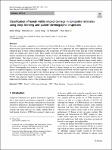Item Infomation
Full metadata record
| DC Field | Value | Language |
|---|---|---|
| dc.contributor.author | Kailun, Deng | - |
| dc.contributor.author | Haochen, Liu | - |
| dc.contributor.author | Lichao, Yang | - |
| dc.date.accessioned | 2023-04-25T07:56:59Z | - |
| dc.date.available | 2023-04-25T07:56:59Z | - |
| dc.date.issued | 2023 | - |
| dc.identifier.other | https://link.springer.com/article/10.1007/s00521-023-08293-7 | - |
| dc.identifier.uri | https://dlib.phenikaa-uni.edu.vn/handle/PNK/8295 | - |
| dc.description | CC BY | vi |
| dc.description.abstract | With the increasingly comprehensive utilisation of Carbon Fibre-Reinforced Polymers (CFRP) in modern industry, defects detection and characterisation of these materials have become very important and draw significant research attention. During the past 10 years, Artificial Intelligence (AI) technologies have been attractive in this area due to their outstanding ability in complex data analysis tasks. Most current AI-based studies on damage characterisation in this field focus on damage segmentation and depth measurement, which also faces the bottleneck of lacking adequate experimental data for model training. This paper proposes a new framework to understand the relationship between Barely Visible Impact Damage features occurring in typical CFRP laminates to their corresponding controlled drop-test impact energy using a Deep Learning approach. A parametric study consisting of one hundred CFRP laminates with known material specification and identical geometric dimensions were subjected to drop-impact tests using five different impact energy levels. | vi |
| dc.language.iso | en | vi |
| dc.publisher | Springer | vi |
| dc.subject | CFRP | vi |
| dc.subject | AI | vi |
| dc.title | Classification of barely visible impact damage in composite laminates using deep learning and pulsed thermographic inspection | vi |
| dc.type | Book | vi |
| Appears in Collections | ||
| OER - Công nghệ thông tin | ||
Files in This Item:

